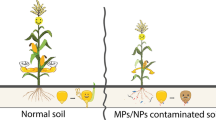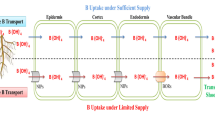Abstract
Phytoremediation with the use of hyperaccumulating plant species to remove excess trace metals from contaminated soil and water is considered a cost-effective non-invasive technique. Over 400 plant taxa worldwide have been identified as natural hyperaccumulators, but only very few are reported to hyperaccumulate Cd. Bidens pilosa L. is a newly found, promising Cd hyperaccumulator, although its potential to accumulate Cd and mechanism of this process are not yet well known. This paper was aimed at exploring hyperaccumulation capacity of B. pilosa for Cd, and its translocation behavior related to cell membrane permeability. The highest Cd concentration in shoots of B. pilosa grown in soil was 405.91 mg kg−1 and of that cultured in nutrient solution 1651.68 mg kg−1, indicating very high accumulation potential. Cd concentrations in the root, stem, leaf, and shoot of B. pilosa cultured in nutrient solution were all much higher than those in soil, while biomass development was considerably lower. This resulted in lesser differences between Cd maximum accumulation loads in the shoot (462 and 365 μg pot−1) and in the root (100 and 96 μg pot−1) of B. pilosa grown in solution and in soil, respectively. Relative electric conductivity (REC), K+ relative permeability ratio, and MDA (malondialdehyde) contents, which are major indices expressing cell membrane permeability, appeared to be closely related to Cd translocation and accumulation. The relative molecular mechanism of Cd accumulation/translocation in B. pilosa was found of importance and needs to be elucidated.








Similar content being viewed by others
References
Adriano DC, Wenzel WW, Vangronsveld J, Bolan NS (2004) Role of assisted natural remediation in environmental cleanup. Geoderma 122:121–142
Baker AJM, Brooks RR (1989) Terrestrial higher plants which hyperaccumulate metallic elements—a review of their distribution, ecology and phytochemistry. Biorecovery 1:81–126
Baker AJM, Reeves RD, Hajar ASM (1994) Heavy metal accumulation and tolerance in British population of the metallophyte Thlaspi caerulescens J & C. Presl (Brassicaceae) New Phytol 127:61–68
Gao RZ (2012) Plant physiology. Higher Education Press, Beijing
He S, He Z, Yang X, Stofella PJ, Baligar VC (2015) Soil biogeochemistry, plant physiology, and phytoremediation of cadmium-contaminated soil. Adv Agro 134:135–225
Ji PH, Song YF, Sun TH, Liu Y, Cao XF, Xu D, Yang XX, Mcrae T (2011) In situ cadmium phytoremediation using Solanum nigrum L.: the bioaccumulation characteristics trail. I J Phytoremeidiation 13:1014–1023
Li ST, Liu R, Wang M, Wang XB, Shan H, Wang HT (2006) Phytoavailability of cadmium to cherry-red radish in soils applied composted chicken or pig manure. Geoderma 136:260–271
Liu L, Chen HS, Cai P, Liang W, Huang QY (2009) Immobilization and phytotoxicity of Cd in contaminated soil amended with chicken manure compost. J Hazard Mater 163:563–567
Marques APGC, Rangel AOSS, Castro PMI (2009) Renediation of heavy metal contaminated soils: phytoremediation as a potentially promising clean-up technology. Crit Rev Environ Sci Technol 39:622–654
Munn J, January M, Cutright TJ (2008) Greenhouse evaluation of EDTA effectiveness at enhancing Cd, Cr, and Ni uptake in helianthus annuus and Thlaspi caerulescens. J Soils Sediments 8:116–122
Quartacci MF, Irtelli B, Baker AJM, Navari-Izzo F (2007) The use of NTA and EDDS for enhanced phytoextraction of metals from a multiply contaminated soil by Brassica carinata. Chemosphere 68:1920–1928
Ravanbakhsh M, Ronaghli A-M, Taghavi SM, Jousset A (2016) Screening for the next generation heavy metal hyperaccumulators for dryland decontamination. J Environ Chem Eng 4:2350–2355
Sidhu GPS, Singh HP, BAtush DR, Kohli RK (2017) Tolerance and hyperaccumulation of cadmium by a wild, unpalatable herb Coronopus didymus (L.) SM (Brassicaceae). Ecotox Environ Saf 135:209–215
Tang L, Yao A, Yuan M, Tang Y, Liu J, Liu X, Qiu R (2016) Transcriptional up-regulation of genes involved in photosynthesis of the Zn/Cd hyperaccumulator Sedum alfredii in response to zinc and cadmium. Chemosphere 164:190–200
Van der Ent A, Baker AJM, Reeves RD, Pollard AJ, Schat H (2013) Hyperaccumulators of metal and metalloid trace element: facts and fiction. Plant Soil 362:319–334
Wang AY, Huang SS (2010) Response of three herbaceous plants to Cr6+ stress. Acta Agric Boreali-occiden Sin 19:164–167
Wei SH, Twardowska I (2013) Main rhizosphere characteristics of the cd hyperaccumulator Rorippa globosa (Turcz.) Thell. Plant Soil 372:669–681
Wei SH, Zhou QX (2008) Screen of Chinese weed species for cadmium tolerance and accumulation characteristics. I J Phytoremediation 10:584–597
Wei SH, Zhou QX, Zhan J, Wu ZJ, Sun TH, Lyubu Y, Prasad MNV (2010) Poultry manured Bidens tripartite L. extracting cd from soil - potential for phytoremediating cd contaminated soil. Bioresour Technol 101:8907–8910
Wei SH, Wang SS, Li YM, Zhu JG (2013) Root system responses of hyperaccumulator Solanum nigrum L. to Cd. J Soils Sediments 13:1069–1074
Wei SH, Bai JY, Yang CJ, Zhang QR, Knorr KH, Zhan J, Gao QH (2016) Compound amino acids added in media improved Solanum nigrum L. phytoremediating Cd-PAHs contaminated soil. I J Phytoremediation 18: 358–363
Zaier H, Ghnaya T, Ben RK, Lakhdar A, Rejeb S, Jemal F (2010) Effects of EDTA on phytoextraction of heavy metals (Zn, Mn and Pb) from sludge-amended soil with Brassica napus. Bioresour Technol 101:3978–3398
Zeng X-W, Qui R-L, Yuing R-R, Tang Y-T, Fanf X-H (2011) The differentially-expressed proteome in Zn/cd hyperaccumulator Arabis paniculata Franch. In response to Zn and Cd. Chemosphere 82:321–328
Zhong Q, Kang M, Guo M, Wang XH, Wang LY, Yan ER (2011) Leaf frost sensitivity and percentage of electrolyte permeability of the evergreen woody species in Tiantong region. Zhejiang Province J East China Normal Univ Nat Sci 4:45–52
Acknowledgements
This work was supported by the National Natural Science Foundation of China (41571300, 31270540, and 31070455) and Special Plan in the Major Research & Development of the 13rd Five-Year Plan of China (2016YFD0800802), Qinling-Bashan Mountains Bioresources Comprehensive Development, Collaborative Innovation Center (QBXT-Z(P)-15-7), and Hanjiang Scholar Program of Shaanxi Sci-Tech University. The contribution of IEE-PAS (Poland) was performed within its statute activity (project 1a-109 NZ).
Author information
Authors and Affiliations
Corresponding author
Additional information
Responsible editor: Elena Maestri
Rights and permissions
About this article
Cite this article
Dai, H., Wei, S., Twardowska, I. et al. Hyperaccumulating potential of Bidens pilosa L. for Cd and elucidation of its translocation behavior based on cell membrane permeability. Environ Sci Pollut Res 24, 23161–23167 (2017). https://doi.org/10.1007/s11356-017-9962-9
Received:
Accepted:
Published:
Issue Date:
DOI: https://doi.org/10.1007/s11356-017-9962-9




